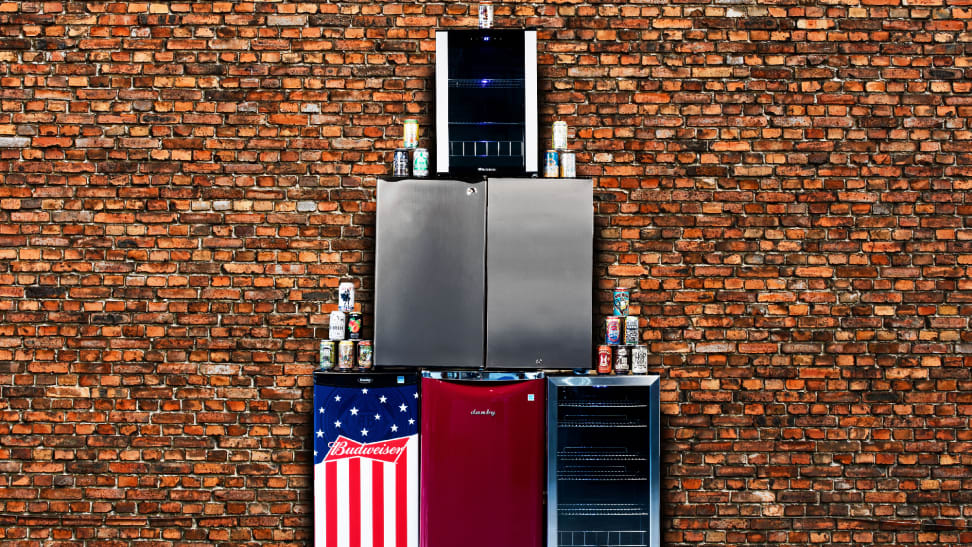 — Recommendations are independently chosen by Reviewed’s editors. Purchases you make through our links may earn us a commission.
— Recommendations are independently chosen by Reviewed’s editors. Purchases you make through our links may earn us a commission.No matter whether you drink Bud Light or nerd out over craft brews, or if you're outfitting a home bar or a man cave, you'll need a place to chill all those cans and bottles.
There are hundreds of beverage coolers and mini fridges out there to choose from. Some of them are surprisingly large, while others are impractically small. Still, others require built-in installation. For this guide, we chose to focus on some of the most popular models at manageable sizes and affordable price points, to help you find the most practical option.
After testing them for both capacity and temperature range control, we used our years of kitchen fridge testing experience to figure out just which one you should buy. That's why we recommend the Wine Enthusiast Evolution Series Beverage Center (available at Amazon) as the best beer fridge to buy.
Here are the best beer fridges we tested:
- Wine Enthusiast Evolution Series Beverage Center
- Igloo 3.2-Cu.-Ft. Platinum Fridge
- Danby Contemporary Classic Chrome Line
- Danby 3.3-Cu.-Ft. Beverage Center
- EdgeStar 3.2-Cu.-Ft. Beverage Center
- Avanti 3.2-Cu.-Ft. Mini Fridge
- NewAir 126-Can Beverage Center
- EdgeStar 3.6-Cu.-Ft. Beverage Center
- Whynter 5.75-Cu.-Ft. Beverage Center
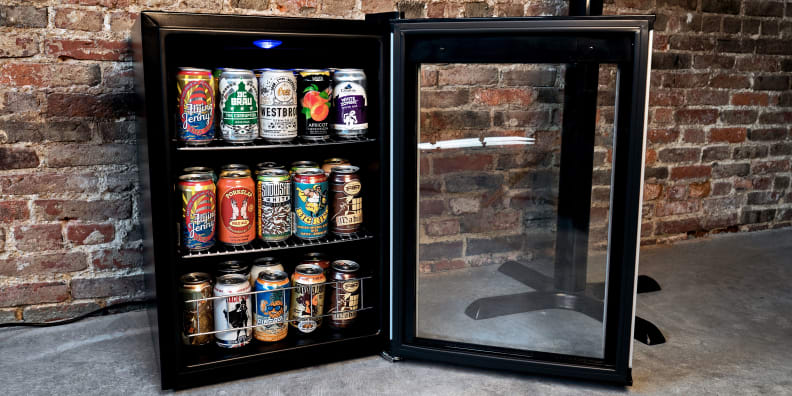

The Wine Enthusiast Evolution Series is, without question, the best beer fridge you can buy. It's a beverage center, which means it's designed specifically to hold cans and bottles. With an advertised 2.2-cu.-ft. capacity—almost half the size of some other models on our list—this is the smallest unit we tested. But don’t let that fool you: Its clever layout means it can hold as much beer as many larger fridges—up to 86 cans.
On the downside, we estimate it will use about $18 of electricity a year. That's far more than most mini fridges, which use between $2 and $5, but it’s worth the small added expense. Stable temperatures from top to bottom mean you can trust the fridge to take care of even the most sensitive brews.
The best price we could find was $248, which makes it one of the costlier units on this list. But with its sleek glass door design, easy-to-use controls, and adjustable shelving, we definitely think it’s money well spent.
Pros
-
Surprisingly high capacity for its small size
-
Can maintain consistent temperatures
Cons
-
Energy inefficient
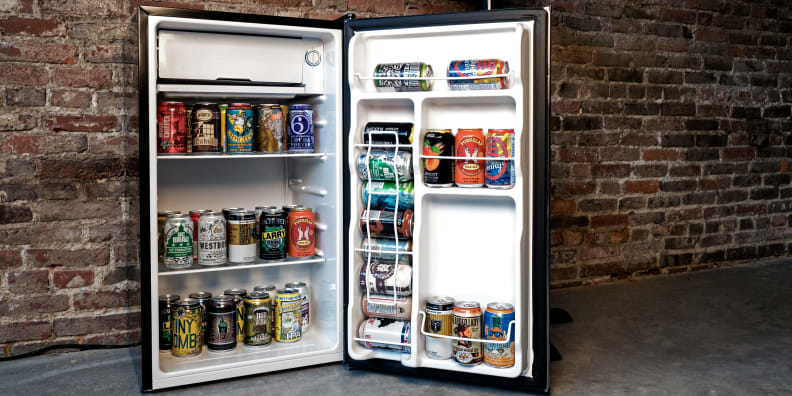

If you're just looking for a cool place to store your suds, but hate having to dig past the mayo to fish out a cold one, then the Igloo FR322 3.2-cu.-ft. Platinum Fridge is your best choice. It fits an impressive 100 cans, so you can even use some of that space for salsa and onion dip.
The Igloo is a conventional mini fridge—the kind you'd find in a college dorm—complete with a can dispenser on the door and a small freezer up top. That means temperatures up top are going to be colder than at the bottom, so be careful when positioning your beer—cans may start to freeze if they're on the top row for too long.
There’s an option for every style and budget: The silvery platinum door is the most expensive at about $158 on Amazon, or you can get a bright orange version for just $119 with free Prime shipping. If that doesn't float your boat, there are also white, black, blue, purple, red, and even lime options to choose from.
Pros
-
Impressive 100-can capacity
-
Can dispenser on fridge door
-
Comes with small freezer compartment
Cons
-
Cans close to freezer may freeze
How We Tested Beer Fridges
The Testers
Hi there! We're Reviewed's appliance testing team. Between us, we've spent many years testing major appliances including washers, dryers, refrigerators, dishwashers, vacuum cleaners, and robot vacuum cleaners.
We have plenty of experience testing these products in the lab, but we've also used them as normal people would in the course of their daily lives, which means that we have a great sense for what appliances are bargains at their price points, and which appliances have really useful extra features (as opposed to the kitchen-sink approach to features).
The Tests
We test each beer fridge from two perspectives—first, from a data-driven, objective point of view, and second, as a regular person trying to get at the leftover Chinese food. The combination of these two types of experiences allows us to recommend the best fridge for you at any price point.
Refrigerators pull in air and cool it down to temperatures cold enough (usually around 37°F) to preserve food and limit bacterial growth. This cooling method means that fridges are very sensitive to air conditions. In hot weather, the condenser and cooling coils have to work harder to cool the warmer air. In cold weather, it may get so cold that the fridge condenser doesn’t turn on. This is why, if you happen to have a second fridge in your sweltering hot or freezing cold garage, you may have noticed that the air inside that fridge is not as cold as the air inside your kitchen fridge.
To avoid these temperature effects, we test each refrigerator in a lab that conditions the air temperature to 72°F +/- 5°F (basically, room temperature), and relative humidity to 50% RH +/- 15% RH. This way, each fridge can perform at its best, and doesn’t get penalized by dealing with warmer or colder air than its competitors.
We spend a week putting each refrigerator through its paces. After packing the fridge with water filled containers (since fridges operate better when there’s less empty space), we measure the fridge’s temperature, humidity loss, freezing time, usable space, and energy use.
- Temperature — Our ideal temperature settings for the fridge and the freezer are 37°F and 0°F, respectively. With fridge temperatures higher than 37°F, you may have to start worrying about bacteria growth, as 40°F is the start of the bacteria “danger zone”. Food isn’t properly frozen at freezer temperatures above 0°F. Once we set each fridge to those temperatures, we collect temperature data throughout the week’s testing that tells us not only how close the temperature in the fridge and freezer are to 37°F and 0°F, respectively, but how close the air temperature stayed to those ideal values.
- Usable Space — One of the most common refrigerator specs is the total capacity, or the volume inside the fridge, in cubic feet. You’d think that a higher capacity means more storage, but that’s not always the case as shelves, drawers, and ice makers can eat into that capacity. We measure the usable space, which is how much empty space is actually available in the fridge’s interior to store your food and drinks.
- Energy Use — Using an electric meter, we measure the fridge’s energy usage (in Watt-hours) over the week of testing. The less energy used, the more efficient that fridge is, and the more money it’ll save you on utility bills in the future.
We also use each fridge in a more casual sense so that we can answer usability questions about the fridge’s specs and features, like the doors, shelves, controls, water/ice dispenser, and extras like smart connectivity, door-in-door or flexible storage options, etc. If a refrigerator keeps the temperature at a perfect 37°F, but it’s very difficult to open the doors and the control panel makes no sense, we’re going to penalize that fridge with respect to its ease of use.
What You Should Know Before Buying A Beer Fridge
How Long Does Beer Last In A Fridge?
In general, beer can last from six to eight months in a fridge—but the quality of the fridge could make it last longer or cut into its lifespan. Make sure to get a beer fridge with excellent internal temperature consistency if you want to up the shelf life of your suds.
What Temperature Should a Beer Refrigerator Be?
Ideally, your fridge should be exactly 37°F, but if it's a dedicated beer fridge it's best to set it between 50°F and 55°F—just make sure to not also store perishable food in there! Microorganisms can proliferate more rapidly at temperatures above 40°F, which will turn leftovers into new ecosystems. For beer, however, it lets yeast continue to do its thing.
What's best for your beer: a mini fridge or beverage center?
The line between what constitutes a beverage center and a mini fridge is a bit blurry, but in general a beverage center includes basically every dedicated storage area for beverages. This can include everything from a small, stand-alone, mini fridge to a separate drawer compartment in a full-size fridge that has its own temperature controls. In general, because beverage centers are built specifically for storing beverages, they often do a better job with the details than a mini fridge, which are built for more general storage. Beverage centers will often have better storage solutions for corralling bottles and cans, come with their own temperature controls, and can (and should) run much warmer than you should ever keep your fridge. In general, beverage centers will be better for your purposes than a mini fridge as they are more specifically purpose-built for the task of keeping cans cold.
How Long Do Refrigerators Last?
While the lifespan of any appliance can vary wildly due to several factors, you should expect your fridge to last for about 10 years.
Most manufacturers will at least cover the first year in their warranty, but some companies will offer more robust programs that will cover specific parts up to five years, 10 years, or for the lifetime of the product.
Other Beer Fridges We Tested

If your taste runs retro and price is no concern, consider the Danby Contemporary Classic Chrome Line Special Edition mini fridge in scarlet metallic red. This 4.4-cu.-ft. beauty turns the looks up to 11, with chrome trim on the door, black interior lining, glass shelves, and white LED lights. Mini fridges just don't get any more stylish.
And it’s more than a pretty face, too: This Danby was one of the best performing products we tested, offering up style and substance.
There's one major drawback: it’s expensive. Depending on where you look, this fridge runs between $300 and $350—almost twice as much as some competitors (though none of them look this good). It’s hard to find, too: This special edition is a recent release and it can’t yet be bought at any major retailer. If you like the look and can afford the price, though, we think it’s worth the effort to track it down in-store or try your luck with a third-party online reseller.
Pros
-
Stylish, retro look
-
Brightly-lit interior
-
Angled can dispenser
Cons
-
Nothing we could find

Not only does Danby make a killer mini fridge, it also makes an impressive beverage center. The glass-front DBC120BLS served up fantastically consistent temperatures from top to bottom. On the downside, it only fit 85 cans; our top pick is over a full cubic foot smaller, but managed to fit one more than this Danby.
Most importantly, though, it’s really easy to find: More retailers are selling this fridge than any other on our list, and at a consistently low price. At about $195, this Danby is the cheapest beverage refrigerator we tested.
Pros
-
Glass door makes it easy to see beers at a glance
-
Easy to find and buy online
Cons
-
Lower capacity than expected for its size
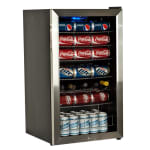
The EdgeStar BWC120SSLT is probably the most straightforward beverage center we tested, and proved to be perfectly adequate. On the outside, we like the silver trim all around the glass door, as well as the LED internal lighting. The door lock is also a nice touch, and it was the only fridge we tested with a bottle rack.
Considering its middling performance and a high $289 price, however, it doesn’t seem to offer any tangible advantage over the Wine Enthusiast model, especially if you’re a fan of cans.
Pros
-
Glass door makes it easy to see beers at a glance
-
Brightly-lit interior
Cons
-
Nothing we could find

The Avanti AR321BB is another basic mini fridge that didn’t make much of an impression on us. Temperature output was fine and can capacity was average, but the bland design and lack of a door-mounted can dispenser left something to be desired.
Still, it’s a perfectly adequate fridge, especially if you can find it on sale. But with prices hovering around the $210 mark, it just can’t compete with the other products on this list.
Pros
-
Can maintain consistent temperatures
Cons
-
No door-mounted can dispenser
-
Relatively high price for few features
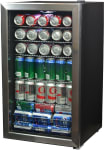
The NewAir AB-1200 126-can cooler is the quintessential beverage center. With its glass door, silver trim, blue LED lighting, and adjustable shelves, it looks—and feels—great.
However, the top shelf was a good five degrees warmer than the bottom. If the upper shelf is the right temperature, the lower cans could be too warm; if the bottom is just right, the top shelf might start to freeze. It's just not great whichever way you slice it.
The lowest price we could find was $283 on Amazon, which is just too much money for a fridge that can't compete with other options like the Wine Enthusiast. Plus, we could only get 118 cans to fit at once—not quite the advertised 126.
Pros
-
Stylish looks
-
Adjustable shelves
Cons
-
Temperature not consistent throughout
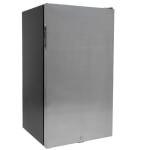
Of all the beverage centers we tested, the EdgeStar BWC120SLD was the only one that featured an opaque stainless door. It's one you should probably stay away from, but not just for that reason.
For a sky-high $299—more than almost any other fridge in our roundup—you get temperatures that vary over time, which can be very bad for beer.
And as clean and crisp as its stainless exterior may look, it just doesn’t offer the utility of the elegant glass doors and blue LED lighting found on all the other beverage centers we tested. You have to open it just see inside. At these prices, we want luxury, darn it!
Pros
-
Stainless steel finish
Cons
-
Doesn't maintain consistent temperatures

Aside from its handle, the Whynter BR-130SB beverage center is almost identical to the NewAir in every way. The blue lights and silver door trim initially impressed us, but we again lost interest when we discovered this unit's iffy temperature consistency.
While we found the NewAir to be merely mediocre, we’re slapping our "Avoid" label on the Whynter due to some service issues. The model we tested used more than 100 times the expected amount of energy, so we assumed something was wrong. We reached out to the manufacturer via e-mail, which proved to be decidedly unhelpful in resolving the issue. This does not speak well for quality control or future support.
Pros
-
Stylish looks
-
Adjustable shelves
Cons
-
Energy inefficient

